Romania, nestled in the heart of Eastern Europe, is a country renowned for its stunning landscapes, rich history, and vibrant culture. From the majestic Carpathian Mountains to the scenic Black Sea coast, Romania offers a diverse range of experiences for travelers.
The country is famous for its folklore, medieval castles, and charming villages, making it a unique destination for those seeking adventure and history. With a blend of tradition and modernity, Romania invites visitors to explore its enchanting landscapes and discover its intriguing past.
Table of Contents
Geography
Romania is located in Southeastern Europe, bordered by Ukraine to the north, Moldova to the east, the Black Sea to the southeast, Bulgaria to the south, Serbia to the southwest, and Hungary to the west. Covering an area of approximately 238,397 square kilometers, Romania is the twelfth largest country in Europe.
The country’s diverse geography includes the towering peaks of the Carpathian Mountains, which run through the center of Romania, and the picturesque plains and rolling hills of Transylvania. Romania is also home to the Danube River, one of Europe’s longest rivers, which flows through the country before emptying into the Black Sea. The natural beauty of Romania, with its vast forests, pristine rivers, and rich wildlife, offers ample opportunities for outdoor activities such as hiking, skiing, and birdwatching.
States of Romania
Romania is divided into 41 counties, not states, and one municipality, which is Bucharest, the capital city. These counties are the primary administrative divisions of the country.
Here is a table listing all 41 counties of Romania along with their capitals:
| No. | County | Capital |
|---|---|---|
| 1 | Alba | Alba Iulia |
| 2 | Arad | Arad |
| 3 | Argeș | Pitești |
| 4 | Bacău | Bacău |
| 5 | Bihor | Oradea |
| 6 | Bistrița-Năsăud | Bistrița |
| 7 | Botoșani | Botoșani |
| 8 | Brașov | Brașov |
| 9 | Brăila | Brăila |
| 10 | Buzău | Buzău |
| 11 | Caraș-Severin | Reșița |
| 12 | Călărași | Călărași |
| 13 | Cluj | Cluj-Napoca |
| 14 | Constanța | Constanța |
| 15 | Covasna | Sfântu Gheorghe |
| 16 | Dâmbovița | Târgoviște |
| 17 | Dolj | Craiova |
| 18 | Galați | Galați |
| 19 | Giurgiu | Giurgiu |
| 20 | Gorj | Târgu Jiu |
| 21 | Harghita | Miercurea Ciuc |
| 22 | Hunedoara | Deva |
| 23 | Ialomița | Slobozia |
| 24 | Iași | Iași |
| 25 | Ilfov | Bucharest* |
| 26 | Maramureș | Baia Mare |
| 27 | Mehedinți | Drobeta-Turnu Severin |
| 28 | Mureș | Târgu Mureș |
| 29 | Neamț | Piatra Neamț |
| 30 | Olt | Slatina |
| 31 | Prahova | Ploiești |
| 32 | Sălaj | Zalău |
| 33 | Satu Mare | Satu Mare |
| 34 | Sibiu | Sibiu |
| 35 | Suceava | Suceava |
| 36 | Teleorman | Alexandria |
| 37 | Timiș | Timișoara |
| 38 | Tulcea | Tulcea |
| 39 | Vaslui | Vaslui |
| 40 | Vâlcea | Râmnicu Vâlcea |
| 41 | Vrancea | Focșani |
*Note: Bucharest (București) is the capital of Romania and also serves as the capital of Ilfov County, although it is administratively separate from the county itself.
History
Romania’s history is a tapestry woven from various influences, cultures, and events. The region was inhabited by Dacians, a Thracian people, before being conquered by the Roman Empire in the early 2nd century AD. The Roman influence left a lasting legacy, with the Latin language forming the basis of the Romanian language. After the fall of the Roman Empire, the territory experienced invasions by various groups, including Goths, Huns, and Slavs, leading to a fragmented political landscape.
During the Middle Ages, the principalities of Wallachia and Moldavia emerged as significant powers in the region. In the 14th century, the Kingdom of Hungary sought to exert control over these territories, leading to a series of conflicts. In 1859, Wallachia and Moldavia united to form the modern state of Romania. The country gained independence from the Ottoman Empire in 1877, becoming a kingdom in 1881.
The 20th century was marked by political upheaval and social change. Romania faced territorial losses during World War I but regained them after the war through the Treaty of Trianon. However, the rise of communism in the post-World War II period drastically altered the political landscape. Romania became a communist state under Nicolae Ceaușescu, who ruled with an iron fist until his overthrow in the 1989 revolution. The transition to democracy and a market economy has shaped Romania’s contemporary identity, leading to its accession to the European Union in 2007.
Top Ten Most Famous Places to Visit in Romania
Bucharest
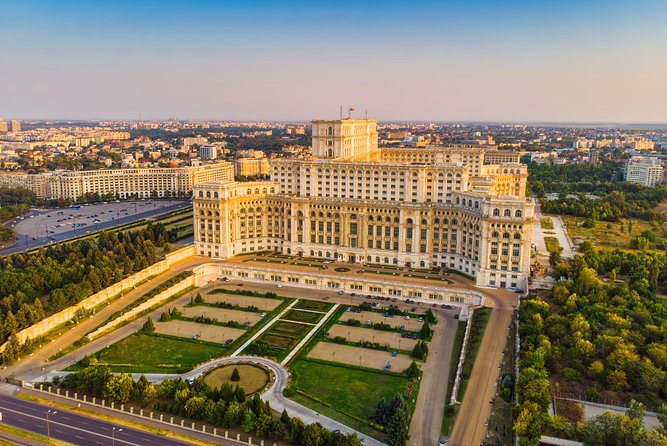
Bucharest, the capital city of Romania, is known for its eclectic architecture, vibrant nightlife, and rich cultural scene. The city boasts impressive landmarks such as the Palace of the Parliament, one of the largest administrative buildings in the world, and the charming Old Town, filled with cafes, restaurants, and historical sites. Visitors can explore the National Museum of Art and enjoy leisurely strolls in Herastrau Park.
Transylvania
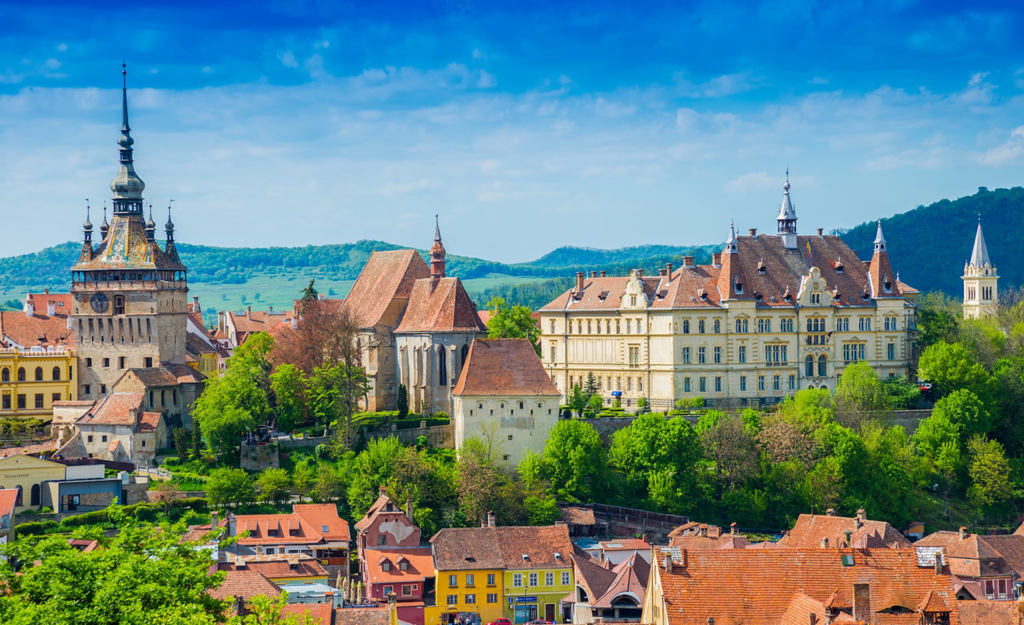
Transylvania is famous for its stunning landscapes, medieval towns, and rich folklore, including the legendary Dracula. The region is dotted with picturesque villages, fortified churches, and castles, such as Bran Castle, often associated with the Dracula myth. The medieval city of Sibiu, with its charming architecture and vibrant cultural scene, is a highlight of the region.
Brasov

Brasov is a charming city nestled at the foot of the Carpathian Mountains, known for its well-preserved medieval architecture and beautiful surroundings. The Black Church, a stunning Gothic cathedral, is one of the city’s most iconic landmarks. Visitors can take a cable car to the top of Tâmpa Mountain for panoramic views of Brasov and the surrounding area.
Cluj-Napoca

Cluj-Napoca, the unofficial capital of Transylvania, is a vibrant city known for its youthful energy and cultural diversity. The city is home to the largest university in Romania, contributing to its lively atmosphere. Visitors can explore the Union Square, visit the beautiful St. Michael’s Church, and enjoy the numerous festivals held throughout the year.
Sighisoara
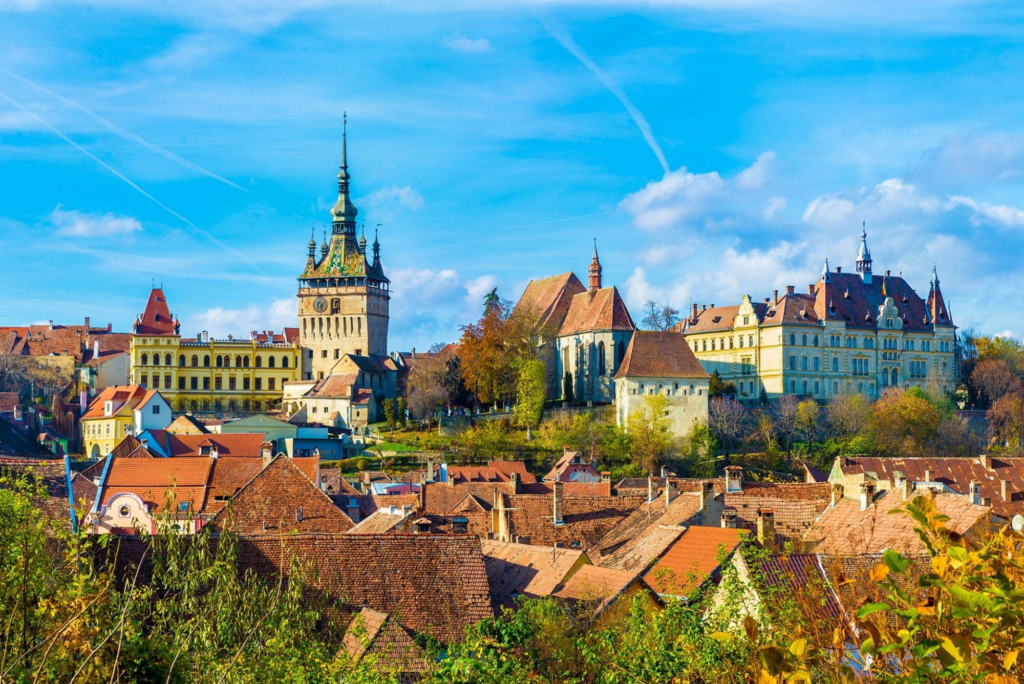
Sighisoara is a UNESCO World Heritage Site and one of the best-preserved medieval towns in Europe. Known as the birthplace of Vlad the Impaler, the inspiration for Dracula, Sighisoara features colorful buildings, cobblestone streets, and a stunning citadel. The Clock Tower and the Church on the Hill are must-visit attractions for history enthusiasts.
Danube Delta

The Danube Delta, a UNESCO Biosphere Reserve, is one of the most biodiverse regions in Europe and a paradise for nature lovers. The delta is home to numerous bird species, including pelicans and herons, and offers opportunities for birdwatching, fishing, and boating. Visitors can explore the charming fishing villages and experience the unique ecosystem of this UNESCO site.
Peles Castle

Peles Castle, located in Sinaia, is a stunning Neo-Renaissance castle nestled in the Carpathian Mountains. Built in the late 19th century, the castle is known for its exquisite architecture, intricate interiors, and beautiful gardens. Guided tours allow visitors to explore the opulent rooms and learn about the castle’s fascinating history.
Sibiu

Sibiu is a cultural gem in Transylvania, known for its medieval architecture and vibrant cultural scene. The city is home to the Brukenthal Palace, one of the oldest museums in Romania, showcasing an impressive art collection. The Great Square and the Bridge of Lies are popular attractions that reflect Sibiu’s rich history and charm.
Constanta
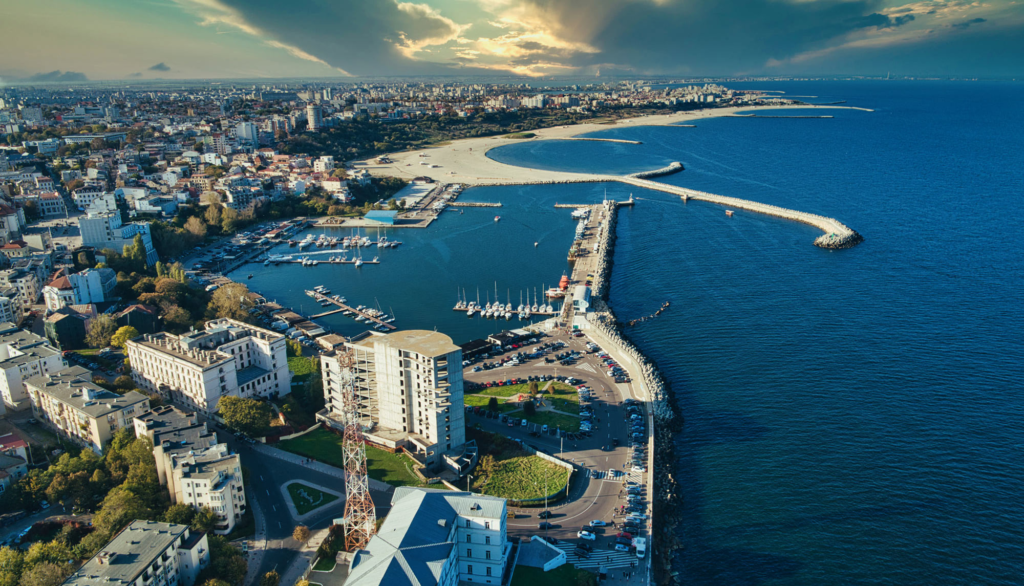
Constanta, located on the Black Sea coast, is Romania’s oldest continually inhabited city and a popular seaside destination. The city features a mix of historical and modern attractions, including the Roman Edifice with Mosaic, the iconic Constanta Casino, and the beautiful beaches along the coast. Visitors can enjoy the vibrant atmosphere and delicious seafood in this coastal city.
The Carpathian Mountains

The Carpathian Mountains, stretching across central Romania, offer breathtaking landscapes and outdoor activities. The region is perfect for hiking, skiing, and wildlife watching, with diverse flora and fauna. The Bucegi National Park and the Retezat National Park are popular destinations for nature enthusiasts, showcasing Romania’s natural beauty.
Culture
The official language of Romania is Romanian, a Romance language that evolved from Latin. Romanian is the only Romance language in Eastern Europe and is spoken by the vast majority of the population. The language has retained many Latin roots while also incorporating Slavic, Greek, Turkish, and Hungarian influences, reflecting Romania’s diverse cultural heritage. Romanian literature has produced notable authors such as Mihai Eminescu and Ion Luca Caragiale, contributing to the country’s rich literary tradition.
Romanian lifestyle is characterized by strong family ties, hospitality, and a connection to tradition. Meals are often a time for gathering with family and friends, featuring traditional dishes such as mămăligă (cornmeal porridge), sarmale (cabbage rolls), and cozonac (sweet bread). Romanians take pride in their customs and traditions, celebrating various festivals and events throughout the year. The rural lifestyle is still prevalent in many areas, with farmers practicing age-old traditions and crafts, preserving Romania’s cultural heritage.
The country boasts a rich tapestry of traditions and customs that vary by region. Folk art, music, and dance play a significant role in Romanian culture, with traditional costumes worn during festivals and celebrations. The country’s folklore is filled with myths, legends, and tales, including the famous stories of Dracula and various supernatural beings. Festivals such as Mărțișor, celebrated in March, mark the arrival of spring and are characterized by the exchange of red and white cords symbolizing health and prosperity.
Festivals
Romania hosts a variety of vibrant festivals throughout the year, celebrating its rich cultural heritage. The George Enescu Festival, held in Bucharest, is one of the most prestigious classical music festivals in Europe, attracting renowned musicians and orchestras.
The Medieval Festival in Sighisoara showcases the city’s historical significance with parades, performances, and traditional crafts. The Transylvania International Film Festival, held in Cluj-Napoca, celebrates cinematic talent and creativity, making it a highlight for film enthusiasts. Additionally, the Untold Festival, one of the largest music festivals in Europe, draws thousands of visitors to experience live performances in a stunning setting.
Economy
Romania’s economy is diverse, with key sectors including agriculture, manufacturing, services, and technology. The country is one of the largest agricultural producers in Europe, known for its crops such as corn, wheat, and sunflowers. The manufacturing sector is robust, producing textiles, automotive parts, and machinery.
In recent years, The country has seen significant growth in its technology and IT industries, becoming a hub for software development and innovation. The country’s strategic location within Europe, combined with its skilled workforce, has attracted foreign investments and contributed to economic development.
Tourism
Tourism is a vital sector of Romania’s economy, drawing millions of visitors each year. The country’s rich history, stunning landscapes, and cultural heritage make it an attractive destination for travelers seeking diverse experiences. Major cities like Bucharest, Cluj-Napoca, and Sibiu offer a blend of historical sites, vibrant culture, and modern amenities.
The natural beauty of the Carpathian Mountains, the Danube Delta, and the Black Sea coast provides ample opportunities for outdoor activities and adventure. Romania’s well-preserved medieval towns, castles, and folklore continue to enchant visitors, making it a captivating destination in Eastern Europe.
Top Eight Most Famous Food of Romania
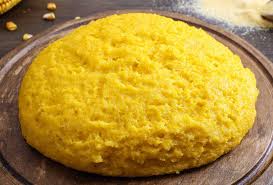
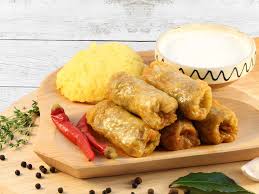






Interesting Facts
- Romania is home to the world’s heaviest building, the Palace of the Parliament in Bucharest.
- The country has the largest population of brown bears in Europe.
- Romania is known for its unique traditional folk music, which varies by region.
- The Carpathian Mountains are often referred to as the “Green Mountains” due to their lush forests.
- The famous poet Mihai Eminescu is considered Romania’s national poet.
- Romania is the birthplace of the famous gymnast Nadia Comăneci, who scored the first perfect 10 in Olympic gymnastics.
- The country has more than 1,000 mineral springs, making it a popular destination for spa tourism.
- Romania is one of the few countries in the world where you can find wild horses roaming free.
- The Hoia Forest, located near Cluj-Napoca, is known for its paranormal activity and legends.
- The Romanian flag features three vertical stripes: blue, yellow, and red, representing liberty, justice, and fraternity.
Future Perspective
Romania is poised for continued growth and development in the coming years, focusing on economic modernization, sustainable tourism, and cultural preservation.
The country aims to enhance its position as a leader in technology and innovation while maintaining its rich cultural heritage. Investments in infrastructure, education, and renewable energy will play a crucial role in shaping Romania’s future. As the country embraces modernization, it seeks to balance progress with the preservation of its unique traditions, ensuring a vibrant and sustainable future for generations to come.
Conclusion
Romania, with its enchanting landscapes, rich history, and vibrant culture, is a country that offers a wealth of experiences for travelers and history enthusiasts alike. From the medieval charm of Transylvania to the bustling streets of Bucharest, and from the natural beauty of the Carpathian Mountains to the unique traditions of its people, Romania’s allure is undeniable. As the country continues to evolve, it remains a destination where history and modernity coexist harmoniously, inviting all to explore its treasures.

